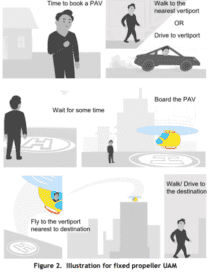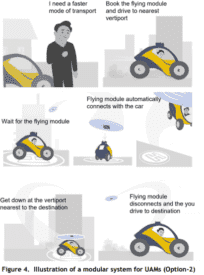For Urban Air Mobility, A Picture May Be Worth Billions of Words

Some people are visual learners. They best understand unfamiliar concepts when they are presented graphically, which is to say, visually, versus by reading text. That’s the principle, four researchers – two from the Indian Institute of Technology in Hyderabad, India, and two from Australia’s Swinburne University of Technology – employed in an effort to help city planners, investors, designers, and policymakers best understand, and ultimately implement, urban air mobility (UAM) around the globe.
Their thesis is perhaps deceptively simple: Draw a picture, a storyboard if you will, to help professionals charged with getting UAM off the ground in their respective cities, regions, and countries.
The notion of telling stories to get a point across is literally millennia-old: “Those who tell stories rule society,” the ancient Greek philosopher, Plato, said.
In their research paper, “Understanding Working Scenarios of Urban Air Mobility,” presented at the International Design Conference in Cavtat, Croatia in May 2022, and published online by Cambridge University Press, Dr. Priyabrata Rautray, Jithin D. Mathew, Dr. Boris Eisenbart, and Dr. Joe Kuys, used an illustration first presented by N.F.M. Roozenburg in 1995, detailing how storyboards can help planners understand how any new concept might work.
The research paper went on to describe several VTOL technologies currently in the advanced stages of development, such as Joby Aviation’s tilt-rotor eVTOL, Airbus’ tilt-wing aircraft, Lilium’s tilt-duct, and Terrafugia’s transformable design.
Trip Planning, UAM-style
The study examined several potential scenarios customers might experience when considering on-demand UAM transportation.

The researchers’ work suggested 10 key requirements those who are designing, building, planning for, and who will be expected to govern, future private and commercial UAM operations:
- A vigorous air traffic control and management system will need to be developed for piloted and uncrewed, intra-city air travel.
- Any network of vertiports being developed should be connected to currently existing transportation hubs, such as airports.
- Planners should set aside parking spaces specifically for UAM operations; they should have easy access to traditional roads and transportation centers.
- Vertiport design and development should plan to accommodate private and commercial UAM operations, including parking and access to power charging facilities.

- Geo-fencing and tagging will be critical to ensure safe, efficient operations.
- Properly defining and classifying urban air space will facilitate greater UAM operations.
- Urban planners will need to account for existing conditions and those UAM operations will bring – e.g., avoid overhead electric cables and plan for multilevel parking.
- Transportation authorities will need a new database management system to keep track of these novel types of vehicles, properly registering and classifying them.
- UAM operations will necessitate the development of an advanced security system to foil potential system hacks and terrorist attacks.
- Developing and enforcing rigorous no-fly zones to ensure privacy, mitigate noise concerns, and avoid collisions, especially in residential or institutional area.

Seeing Is Believing, Understanding, and Achieving
Much, if not most, of the discussion around the impending advent of UAM/AAM, and eVTOLs has been around the technologies that will enable this quantum leap in transportation of people, goods, and services. Fair enough. But, as the authors of “Understanding Working Scenarios of Urban Air Mobility,” explain (illustrate?), sometimes, in order to create the future, you need to see the whole picture – literally, first.


